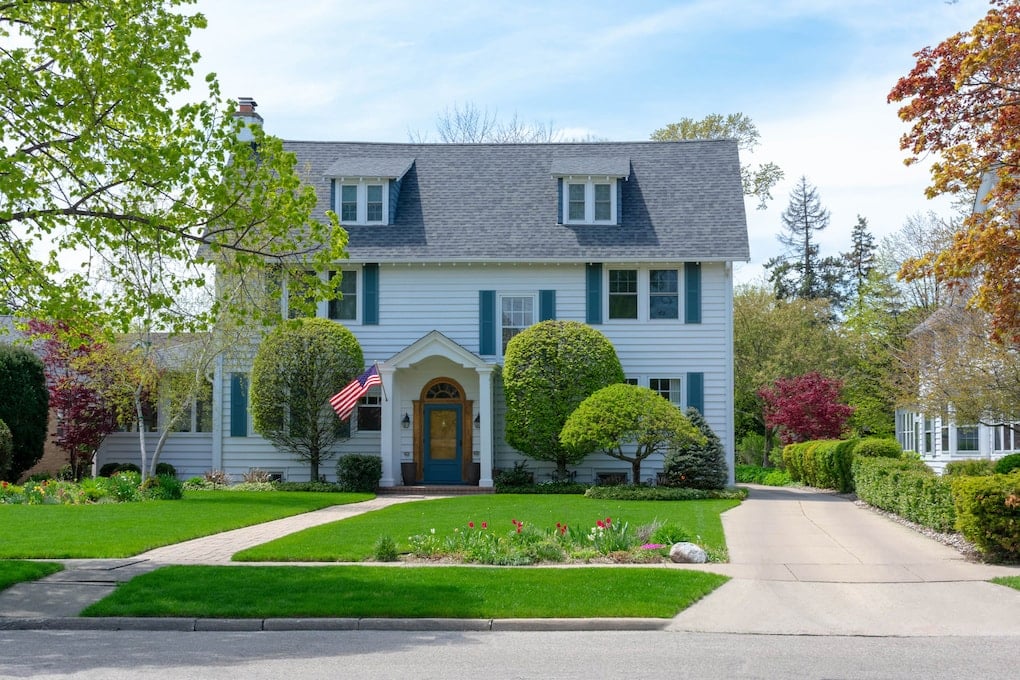If you’re facing a new construction of a home, roof, or addition to your existing home, you’re going to have many decisions to make regarding materials, design, budget, etc.
What might be surprising is that one of the most important decisions is the type of roofing system that will best suit your home! Not only will this play a huge role in the overall style of your home, but it will also affect the function and performance of your home against the elements.
But don’t worry, we’re here to help you choose from common roof types to boost your home’s curb appeal, improve the functionality of your home, and set you and your family up for a long-lasting roof to protect your home for years to come. Ready to start your home or roof construction project?
Let’s get started!
With so many factors to consider, we’re going to help you by listing out some pros and cons of roof styles and what kind of homes they are best suited for.
Gable Roofs
A gable roof is what you imagine when you think of a typical house—square sides with a triangle-shaped roof. Gable roofs are incredibly common amongst many different styles and types of homes. They’re super versatile, and their simple design makes it easy to install and work well to keep your home free of standing water and sheds snow and ice.

Pros of Gable Roofs
- Their simple design makes it super easy to install and is a timeless look, working well for any new construction.
- They don’t require a lot of materials or complicated install, which makes them super affordable.
- High pitch allows for easy water and snow drain off in addition to proper gutters and downspouts.
Cons of Gable Roofs
- They aren’t the best design to fight against severe weather. Strong winds can lift or blow off gable roofs.
- They are the most basic of designs, so if you want to stand out, maybe choose a more unique roof style.
Dutch Gable Roofs
There are many different variations of gable roofs, and we want to cover them all because despite having a similar base component, they can be vastly different and offer even more functionality. The dutch gable roof, for example, combines elements of a simple gable design plus a hip roof on the front. So they can work great for attic spaces on your home or garage and have room to add additional windows for more light.

Pros of Dutch Gable Roofs
- Provide extra attic space and more windows
- Adding windows on the gablet can improve circulation
- Can work as added storage as well if you don’t need extra living space
Cons of Dutch Gable Roofs
- Requires more materials and maintenance
- Has more joints that need to be sealed to prevent leaks
- Snow can build up on the gablet if the pitch is low
Clipped Gable Roofs
A clipped gable roof goes by many names such as bullnose or jerkinhead. It’s called a clipped gable roof because it looks like some clipped off the ends of a basic gable roof, creating a small angle at each corner of the roof. A hip roof has a much bigger “hip” at the end of the roof, but a clipped gable roof will have one much smaller.

Pros of Clipped Gable Roofs
- Even this small detail provides a unique architectural design that will stand out.
- Can be used to showcase shingles on the end for some added dimension and style
- Reduces wind force at the peak of the roof
Cons of Clipped Gable Roofs
- The small joints on the “clipped” gablet require extra attention to avoid leaks at the peak ends of your roof
Gambrel
A gambrel roof is more often than not used on barns or small sheds. There are four surfaces to this roof, starting with a pitched low slope on top, which then bends down in two panels that run the rest of the way down the side of the house. It looks a bit like half an octagon shape. This four-sided design allows for a wider area and makes more head space because the pitch is a little lower and not so steep on the edges. For this reason, this roof works perfectly for barns with upper-level lofts to hold stacked hay.

Pros of Gambrel Roofs
- They are relatively easy to install.
- Can add a lot of extra space on your upper floor, and allow for window installation as well.
- Can work with just about any roofing material.
Cons of Gambrel Roofs
- Can be susceptible to strong wind damage.
- Poor ventilation.
- Difficult to install on existing structures—works best for new construction.
- Susceptible to snow and water accumulation due to its low slope.
Flat Roof
What is more often used in commercial structures like apartment buildings, malls, and office buildings, became widely used on mid-century modern residential homes in the 50s and 60s. It’s important to note that a flat roof is not officially flat—they must have a slight slope of at least 2% to allow for water and snow run-off. Otherwise, you’d just have sitting water that can cause leaks and cave-ins.

Pros of Flat Roofs
- They offer a very unique design you won’t find on most homes.
- The flat roof allows for big, wide-open floor plans.
- There is an opportunity to add on levels to your home.
Cons of Flat Roofs
- Very susceptible to leaks and must be properly sealed.
- Require a bit more maintenance to ensure the sealant (rubber, tar, etc.) remains intact to keep from leaking.
Shed
A shed roof is kind of like a flat roof, but it’s at a much steeper incline. With just a single slope, you will commonly find shed roofs utilized on cabins, barns, and of course, sheds. The high-pitch slope is very simple but perfectly effective for water and snow shed.

Pros of Shed Roofs
- Can be installed very quickly due to needing very few materials.
- Cost-effective
- Works with just about any roofing material.
- Perfect opportunity to install skylights for natural light.
- Prevents standing water.
Cons of Shed Roofs
- Not ideal for larger structures—maybe just stick to sheds and barns.
- Requires a strong gutter and downspouts system to handle double the water on its single slope.
Hip Roofs
A hip roof is made up of 4 equal sloped sides that converge to a ridge in the middle. It’s almost like a pyramid, but not quite. Two sides will meet to form a small flat ridge, while the other two come to a point where it meets the ridge. Hip roofs will have a much slighter slope than other styles, and the majority of your roof’s surface will be visible looking at your home. The increased visibility means it’s essential to pick a roofing color and material that you enjoy as it makes up a large part of your home’s curb appeal. If this is the roof type of your choice, make sure to reach out to a reputable roofing contractor right away.

Pros of Hip Roofs
- The four sides increase stability and allow water to flow off easily.
- Depending on the roof’s size, there can be a lot more attic space with a hip roof.
- Each of the four sides can have gutters and downspouts, making water and snow runoff even better.
- Increase curb appeal—looks great on ramblers and mid-century modern homes.
- Works with a variety of roofing materials/shingles.
Cons of Hip Roofs
- Their intricate design and large surface area make installation more complicated and more costly.
- It may require extra ventilation efforts in the attic.
- Flat sloped hip roofs take away from any headspace in the attic.
Mansard Roofs
Mansard roofs originated in French architecture but have been adopted in America for those wanting extra attic space and room to install Dormer windows on their upper floors. It also has four sides, but then an additional slope and four sides on top, as the picture demonstrates. The sides may be a straight angle or be curved outwards for a unique design.

Pros of Mansard Roofs
- Provide extra attic space and the option to add more windows
- A beautiful, elegant aesthetic
- Keeps the option open to expand
Cons of Mansard Roofs
- Requires more materials and maintenance
- The upper slope creates less-than-ideal drainage, and you can find yourself with standing water or insufficient water shed.
- Obtaining permits to increase the height of your structure can be challenging to get.
- The complex nature of this roof makes installation costs much, much higher than other types of roofs.
Hexagonal Roofs
You are most likely going to find a hexagonal roof on an outdoor gazebo. The hexagonal roof’s shape is an eight-sided roof, where all sides meet at a single point on the top.

Pros of Hexagonal Roofs
- Very durable and versatile.
- Homeowners with even slight carpentry skills can DIY a gazebo + hexagonal roof.
- Protect against inclement weather when outdoors.
- Creates a space for outdoor weddings, dining, etc.
- Allows for installation of mesh screens from the roof edge to the ground to protect against insects.
Cons of Hexagonal Roofs
- Once a hexagonal gazebo is built, it can be difficult to move if needed.
- They only work on certain structures—not ideal for a home.
Saltbox
A saltbox roof is similar to a gable roof as it has two sides with open ends that meet in the middle. However, one side is generally much longer than the other, and it’s also often positioned to have the open ends of the sides of your homes rather than a peak from the front view. They’ve proven very effective in climates that get snow because of their lack of flat spots and high pitch; they allow snow and ice to shed easily.

Pros of Saltbox Roofs
- They are relatively easy to install.
- Can endure strong winds and severe storms.
- Great for water shedding.
- The high pitch can add 1-2 stories of extra space on top for more attic or upper floor space.
Cons of Saltbox Roofs
- The upper floor or attic space will have slanted walls, which can take away from usable living space.
- They require more time and materials to install, which can drive up costs.
Dormer Roof
Dormer roofs are more often called Dormer windows, as they are windows added to a Mansard style house that jut outward like a small room or extension of the upper attic living space. They allow for more natural light and ventilation into the space.

Pros of Dormer Roofs
- They offer a unique design you won’t find on most homes.
- You have increased light and ventilation in your attic or upper floor living area.
- It can be utilized as a small office or art corner.
- Increased functionality and storage space in your attic.
Cons of Dormer Roofs
- Complicated to install—requires a high level of expertise.
- They can be high-maintenance.
- Leave your roof susceptible to leaks.
- Expensive to install.
- Don’t work for just any kind of home style or roof.
Butterfly

Butterfly roofs get their name from, you guessed it, butterflies. The roof is shaped like their wings because rather than point up in the center to meet at the ridge, they point downwards in a V-shape and meet in a valley in the center.
Pros of Butterfly Roofs
- Water collection is the most significant benefit of a butterfly roof. Water quickly collects and runs down the roof’s center crease and into a rainwater barrel or other apparatus that can then utilize that water for gardening, etc.
- Extremely aerodynamic and can withstand strong winds.
- Creates much taller walls on your home’s perimeter, which can then have larger windows installed for more natural light.
Cons of Butterfly Roofs
- This design is unlike any other, and this complex installation can be quite costly.
- Susceptible to snow and water damage, which seems counterintuitive to the advantage of catching rainwater. But with a dip in the center of the roof, excessive snow, ice, and water can collect and cause issues.
Tips on Choosing the Best Type of Roof for Your Home
At Northface, we work with roofs of all shapes and sizes, so we’re well equipped to guide you toward the best roofing solution for your home. However, some types of roofs just don’t work for certain styles or shapes of homes, and we’re here to help you find the best roofing type.
When choosing the best roofing solution for your new home, there are a few critical questions to ask yourself:
- What is my budget?
- Will this type of roof complement my home’s style?
- Does this type of roof have the proper slope?
- Is this roof too heavy for my house’s frame?
- Do I want more or less attic space?
- Do I want to add more natural light?
These questions can help you narrow down the best roofing types for your home. You can also start with your home’s style/aesthetic and go from there. Here are the best roof pairings for various home styles.
Mid-Century Modern
Mid-century modern homes have a lot of clean lines and low slope roofs. So a low-slope hip or flat roof works excellent for this style of home. On the other hand, high pitch roofs just don’t work with a mid-century modern home, which is often one-level ramblers who don’t require the extra space on top. You may even see some butterfly roofs installed on more modern architectural designs.

Craftsmen
A craftsman home benefits from many types of roofs but mainly gable roofing, hip roofs, and dormer roofs. Craftsman homes often have a lot of elements and levels on the roof, which is where dormers and hips, or a combination of different types, give it their unique appeal.

Tudor
A classic tudor home will have a much steeper pitch than other types of homes, and gable roofs work great for this design. Tudors may also showcase dormers on the front of the home with beautiful windows in each.

Colonial
Colonial-style homes will also feature higher pitch gable roofs, maybe some dormers, and also a hip or flat roof on the front for the awning supported by large white pillars.

Cottage
There is no one way to build a cottage home, which is why they can be very unique in their aesthetic and design. You might find some more interesting roofing types on a cottage style home such as mansard roofs, dutch gable, gambrel, or even a high pitch, a-frame gable roof.

Farmhouse
Farmhouse homes will more often than not feature a gambrel roof. It’s the type of roof you most often attribute to a barn or a farmhouse, or you may just have a simple gable roof.

Getting the Best Roof for Your Home
Once you’ve decided on which type of roof you want for your home, now it’s time to find a quality contractor to install it!
Finding the right contractor to install your new roof could arguably be more important than selecting the type of roof. Considering the installation will determine whether or not your roof will be effective against the elements, it shouldn’t take much convincing to take the time to find the best contractor to do the job.
At Northface Construction, we say that your roof is more than something that simply goes on top of your house. You want to make sure it’s not only functional and leak-proof, but the materials and style you use suit your desired aesthetic and boost your curb appeal.
For more information on getting started on your new roof, check out our roofing details here, then contact us to get a FREE quote today!


